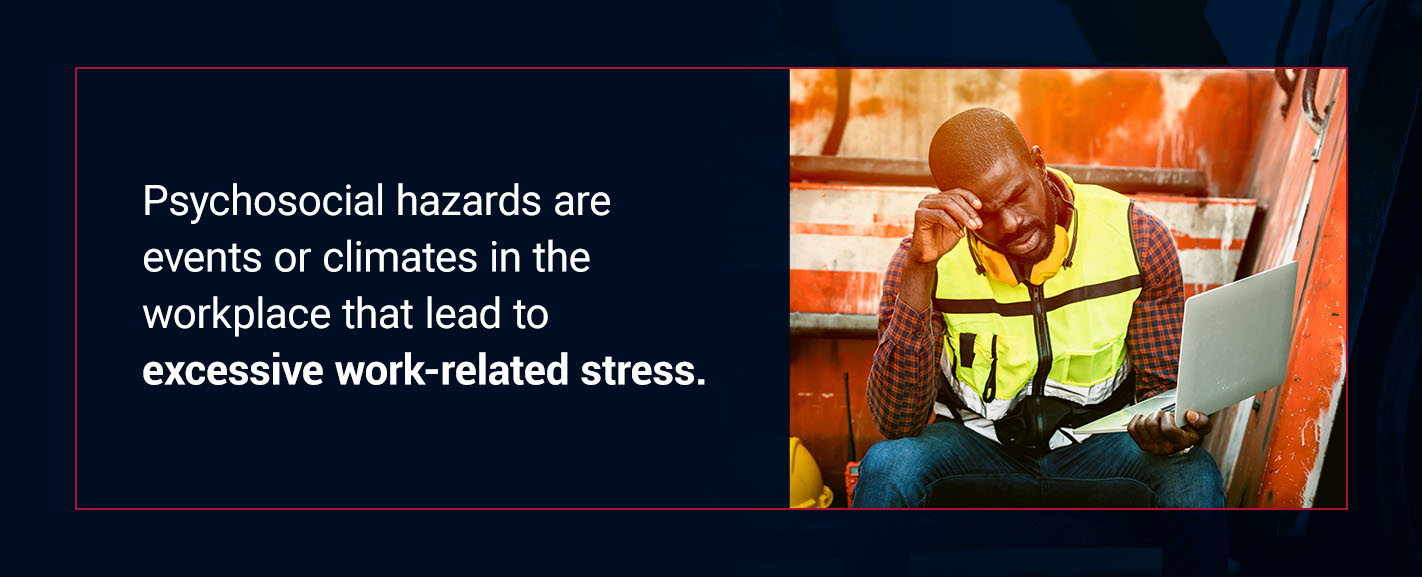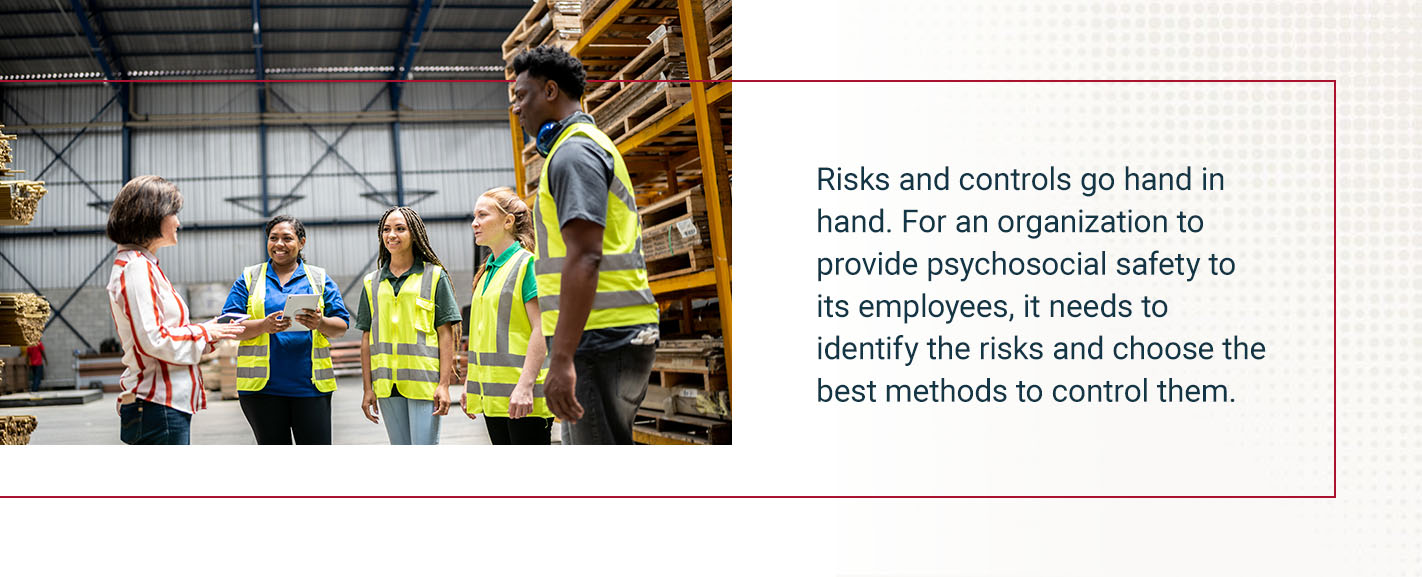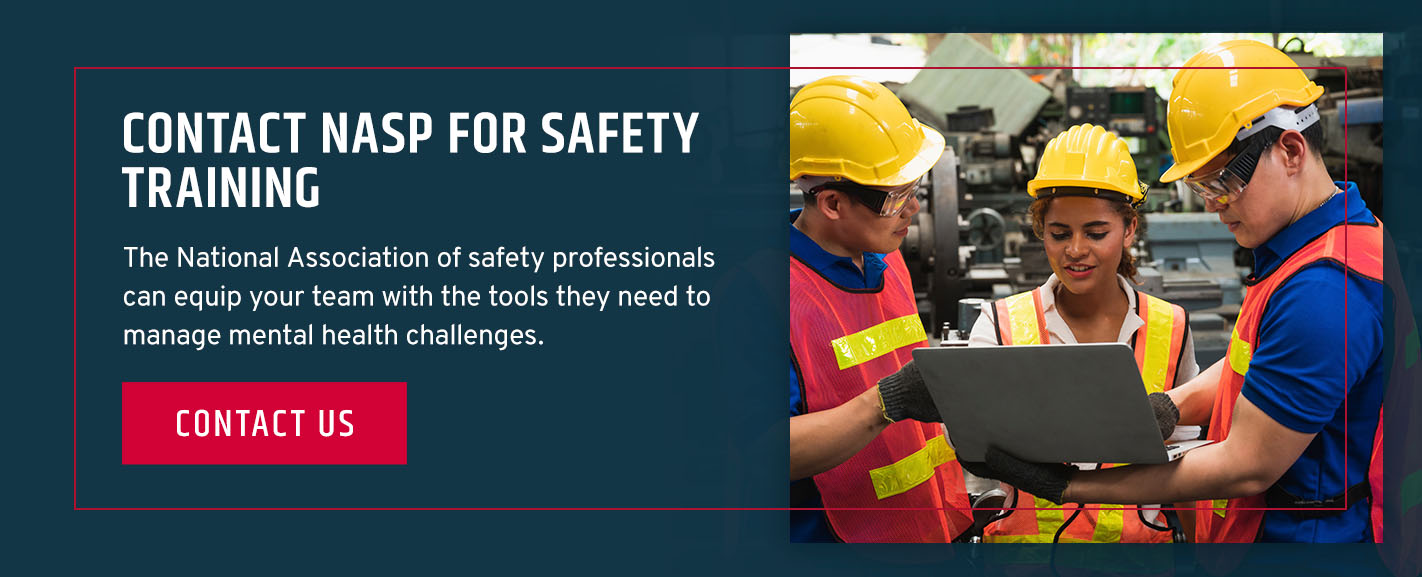Guide to Psychosocial Safety

Safety professionals know how vital worker safety is, and psychosocial safety is no different. Organizations know the value of their workforce — providing psychosocial safety at work is another way to care for teams and enhance productivity.
When employees feel unsupported or their job demands are more significant than their ability to meet them, they experience poor psychosocial safety. Depression and anxiety reduce productivity, costing the global economy $1 trillion annually.
Promoting a positive work environment is necessary for employee satisfaction, productivity, and engagement. To achieve this, safety professionals need a thorough understanding of psychosocial safety and how to help businesses provide a robust psychosocial safety climate for their teams.
What Is Psychosocial Safety?
Mental health in the workplace is a more significant concern than ever, with 87% of employees thinking that actions from their employer would benefit their mental health.
Psychosocial safety is a management practice that prioritizes organizational policies, procedures, and practices to protect workers’ psychological health and safety — integrating critical aspects of psychology and sociology to understand what humans categorize as safe and how they feel safe. If employees feel they have psychosocial safety in the workplace, they believe they won’t be punished or embarrassed for sharing their concerns, ideas, or mistakes.
Businesses work best when employees feel free to innovate and make suggestions. Fear of retaliation can lose organizations valuable insights. Employees feeling like they’re walking on eggshells can cause mental and emotional harm, making them less productive.
In simple terms, psychosocial safety is mental, social, emotional, and spiritual safety. To better understand the concept, it’s best to delve deeper into the theory behind it:
What Is Psychosocial Safety Climate?
Psychological safety climate (PSC) is an organizational psychology term referring to workers’ shared belief that senior management protects and supports their health and safety. A positive PSC increases productivity and attendance, while the reverse will likely promote high work stress and employee dissatisfaction.
Psychosocial Safety Climate Theory
PSC is a work stress theory suggesting that when senior management prioritizes and values their workers’ psychological health and safety, they make decisions to create meaningful work for employees and manage their demands. A positive PSC is essential for reducing work-related mental health challenges, which results in a healthier and more productive workforce.
The psychological safety climate of the workplace is composed of the following systems:
- Management commitment: Senior management takes an active involvement in supporting stress prevention.
- Management priority: Senior management prioritizes employee health and safety over productivity objectives.
- Organizational communication: Organizations provide employees with safe and open communication channels and take action on employee concerns.
- Organizational participation: All levels of the organization, including employees, unions, safety professionals, and management, actively participate and promote staff mental health and safety.
What Is a Psychosocial Hazard?
Psychosocial hazards are events or climates in the workplace that lead to excessive work-related stress. They affect the psychosocial well-being of the workforce and can arise due to several factors, including poor work design and poor social work context. Often, psychosocial hazards result in burnout, low employee satisfaction, high staff turnover, and depression.
Examples of psychosocial hazards include the following:
- Excessive workloads
- Inadequate resources
- Ambiguous role clarity
- Conflicting role demands
- Insufficient involvement in decision-making regarding employee well-being
- Poor management of organizational changes and the resulting job insecurity
- Ineffective communication
- Minimal support from management and team members
- Sexual or psychological harassment in the workplace
- Minimal recognition and reward
- Remote and isolated work
Psychosocial Risk Management
Psychosocial risk is the likelihood of external factors negatively impacting workers’ mental health, including poor work design and social context. Hazards can impair psychological or physical fitness, such as depression and burnout.
The fundamental goal of psychosocial risk management is to balance working conditions and human social factors to foster feelings of self-confidence, work satisfaction, motivation, and physical and mental health. Team members should look forward to their work and be comfortable knowing they are supported and challenged in their environment.
Employees who come into contact with psychosocial hazards run the following risks:
- Poor health
- Reduced functioning
- Increased absenteeism
- Low motivation
- Low morale
- Lost productivity
- Increased stress
With the correct organizational structure and input from safety professionals, many of these risks can be mitigated in the workplace. Managing psychosocial risks is not dissimilar to managing physical ones, and leadership must create and communicate actionable policies similarly.
Psychosocial risk management can include the following steps:
1. Identify Psychosocial Hazards
Psychosocial hazards vary, depending on the industry. A competitive environment with a stigma attached to mental health will have different psychosocial risk factors than a relaxed one. Still, to maximize worker safety, you must identify the hazards in each environment, just as you would identify physical hazards.
It is vital to consult workers in this regard, and anonymous surveys can be an effective tool for gaining actionable feedback. Consult team members in groups and individually to determine the challenges and review staff complaints, incident reports, and staff absenteeism for a multi-angle view of where the hazards appear.
2. Assess the Risks and Prioritize
When you have identified the hazards present in a particular setting, you can complete a risk assessment to determine the risk associated with each hazard. With this information, you can prioritize those areas that require immediate attention.
To assess the risks associated with each hazard, consider the likelihood that the hazard will cause harm to workers — bullying in the workplace is more likely to harm workers than a disagreement about who gets to use the coffee machine. Allow staff members to participate in these assessments, as this encourages innovation and fosters staff engagement in the control measures in the future.
After that, assess the frequency and intensity of exposure to each hazard. If workers are exposed for long periods with no relief, you can classify the exposure as severe, which means it needs management faster. If workers experience constant anxiety and work stress, you can prioritize this over management, providing recognition for the time being.
3. Implement Risk Control Measures
Once you have identified and scaled the risks, you can implement measures to control them. Managing psychosocial risks is more complex in some ways than removing physical ones and often require a combination of control measures for maximum success. The goal should be to eliminate or mitigate risks wherever possible.
4. Monitor and Review
Psychosocial damage can be challenging to identify, so control measures must be monitored and reviewed often to determine their efficacy. In many ways, ongoing and open communication throughout the organization is vital in managing psychosocial risks.
Providing employees with a safe space to share their feedback and concerns will make you aware of the hazards and their effects. This information assists you in deciding how best to adjust risk control techniques.
Risks and Controls of Psychosocial Safety
Risks and controls go hand in hand. To provide psychosocial safety to its employees, an organization must identify the risks and choose the best methods to control them. Practical examples provide the best process for understanding this concept, including the following:
What Does Psychosocial Safety Look Like in Practice?
Every person and work environment is different, so safety professionals must approach risk control measures with the flexibility to determine the best controls in each environment.
Some examples of psychosocial safety risks and controls include the following:
- Poor workplace conditions: If employees struggle to remain productive and positive in their environment, controls could include ergonomic equipment, adequate lighting, reduced exposure to unsafe conditions, and assigning specific spaces for collaboration and quiet work.
- High job demand: Ensure that employees can meet the needs of their position. Management can provide support, clear communication, and workable time frames to employees and encourage a healthy work-life balance.
- Lack of job clarity: Provide workers with clear designations of their roles and duties and prioritize onboarding for new hires.
- Workplace bullying or harassment: Any form of bullying or harassment is a massive psychosocial risk. Controls include implementing strict policies and procedures, training on misconduct, and reporting systems for employees to draw attention to the behavior. Provide mentor systems for employees as additional support.
- Lack of job security: Provide employees feedback on their performance and clear communications surrounding organizational changes to prevent uncertainty and psychological risks.
How to Promote a Positive Work Environment
Safety professionals must take the appropriate steps to help organizations create a positive workplace environment. The process of creating a safe psychosocial environment often begins with policy, but there are many other avenues to explore, including the following:
- Create a positive and supportive culture: Psychosocial safety stems from workplace culture, so the first shift must happen here. Organizations may have to shift their core values and emphasize mutual respect, support, and employee integration. Upper management must champion cultural change, including employees of all levels.
- Prioritize training and onboarding: Allowing employees to learn about company culture and individual expectations from the outset is a powerful tool in mitigating psychosocial risks.
- Action clear policies for bullying and harassment: Employees must feel safe in their work environment, regardless of their background. A zero-tolerance policy for bullying and harassment lets them know you support their differences and provides them with safety in their environment, so they’ll feel comfortable reporting incidents.
- Adjust employee workspaces: Workplace environments affect employees’ psychosocial well-being. Creating an ambient workspace with designated areas for collaboration, focus, and breakout assists employees in their productivity and elevates job satisfaction.
- Foster supportive leadership through training: Leaders must possess the tools to lead effectively. Provide them with training to develop their emotional intelligence and provide psychosocially safe management so that they can treat their team members fairly.
- Construct strong lines of communication: Employees at all levels should feel safe and comfortable sharing feedback and conversing about challenging subjects. Leaders must regularly check in with team members and listen and support them without open judgment or hostility. They must also provide available channels to discuss job specifications and answer questions.
- Facilitate career development: Team members perform better when their roles are clearly defined. They understand the demands associated with their position and can better prioritize, communicate their needs and manage stress. Provide opportunities for career development within each role, with well-defined objectives.
- Provide staff with psychosocial safety training: Train mid-level management to support their teams and employees to recognize when they’re struggling, so they can seek out that support.
- Host team building events: Providing staff members with opportunities to come together and connect on a social level increases employee motivation and provides an enhanced sense of belonging and collaboration.
Benefits of Psychosocial Training for Your Employees
Your organization will benefit from psychosocial training on an individual and group level. The primary benefit is the increased well-being of the workers. Still, psychosocial activity also provides coping skills for employees, so they can focus on their work, recognize when they need assistance, and continue positively influencing company culture.
Some of the many benefits of psychosocial training throughout your organization include the following:
- Reduced stigma: There is a stigma attached to mental health concerns, especially in competitive organizations. When team members throughout your organization receive quality training about the importance of mental health, some of this stigma falls away.
- Improved productivity: When people struggle mentally and emotionally, it’s challenging to focus on their tasks and perform to the best of their ability. Over time, their stress may lead to other problems, such as escapism. Psychosocial training allows workforce members to find stress management techniques in and outside the office, keeping them happier and more productive.
- Enhanced organizational culture: A psychosocial training program lets employees know you care about their well-being and are taking active steps to prioritize it. Employees’ psychosocial safety starts with a cultural shift that allows teams to air their concerns and struggles, increasing engagement and helping to lower burnout.
- Reduced conflict: Employees communicate better when not experiencing mental health challenges. Stress and anxiety can make navigating day-to-day interactions challenging, and they may become conflicts. Psychosocial training helps employees manage their stress and interactions with others, leading to better conflict resolution.
- Improved employee health and wellness: All organizations care about their employees’ well-being. Psychosocial training gives employees the tools and structures to manage their physical and mental health and fosters a sense of community.
- Reduced staff turnover: Not only do people perform at their best when they have access to management techniques that help get them through the day, but they are more likely to stay in a job that values their contributions and overall well-being.
- Increased collaboration and innovation: Employees who feel free to express their ideas and concerns add valuable insight to projects. When everyone feels they’re working on the same team, they are invested in their outcomes.
Contact NASP for Safety Training
Mental health safety is a critical issue in many organizations. The National Association of safety professionals can equip your team with the tools to manage mental health challenges. Our Behavior-Based Safety Specialist and Human and Organizational Performance (HOP) Certificate courses can help you create a safe environment for your workers to thrive. In addition, NASP can provide your team with a customized, site-specific course on psychosocial safety development and implementation for groups of ten (10) or more.
NASP training courses are specifically formulated to boost student retention and focus on building a safety culture within your organization. The in-depth content of our courses can help safety professionals achieve certifications or continue developing their skills. Let our training help you create an environment where team members feel safe communicating their concerns, so you can provide them with the resources they need to stay safe at work. Feel free to browse our selection of courses or contact us for more information today.
Behavior-Based Safety Specialist | Human and Organizational Performance (HOP) Certificate
Blog Posts
Latest Posts
Related Posts








